fuel type Lancia Delta 2012 Owner handbook (in English)
[x] Cancel search | Manufacturer: LANCIA, Model Year: 2012, Model line: Delta, Model: Lancia Delta 2012Pages: 295, PDF Size: 8.29 MB
Page 11 of 295
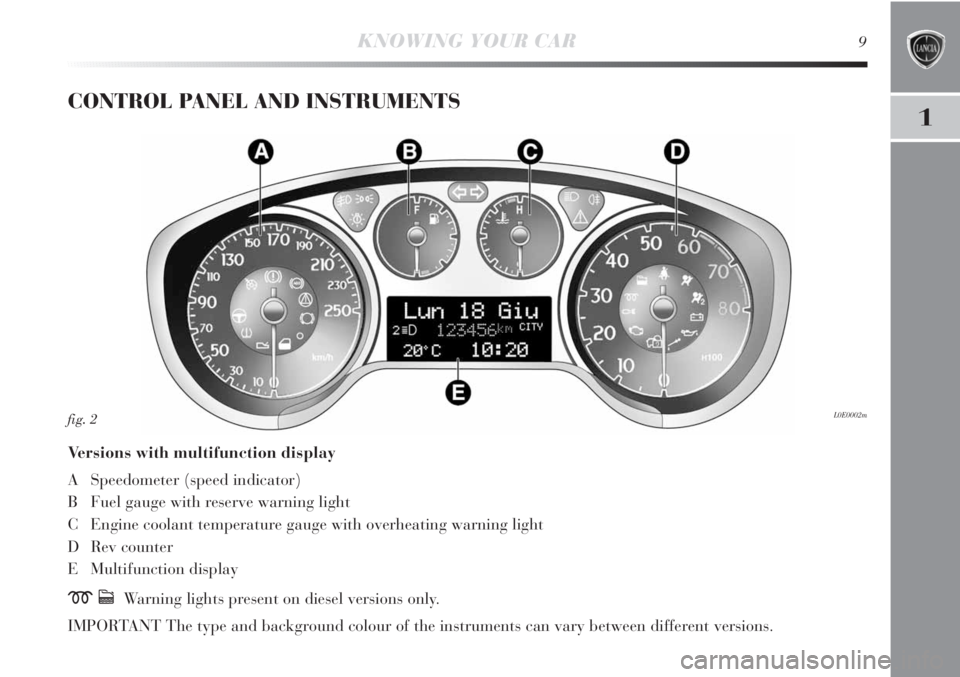
1
KNOWING YOUR CAR9
CONTROL PANEL AND INSTRUMENTS
Versions with multifunction display
A Speedometer (speed indicator)
B Fuel gauge with reserve warning light
C Engine coolant temperature gauge with overheating warning light
D Rev counter
E Multifunction display
mcWarning lights present on diesel versions only.
IMPORTANT The type and background colour of the instruments can vary between different versions.
L0E0002mfig. 2
Page 12 of 295
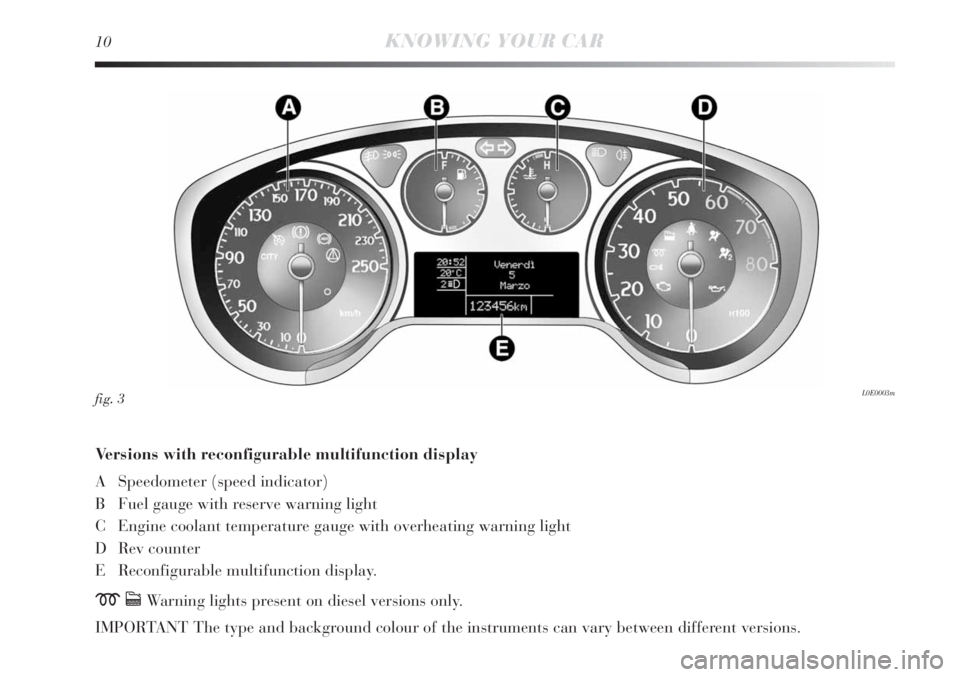
10KNOWING YOUR CAR
Versions with reconfigurable multifunction display
A Speedometer (speed indicator)
B Fuel gauge with reserve warning light
C Engine coolant temperature gauge with overheating warning light
D Rev counter
E Reconfigurable multifunction display.
mcWarning lights present on diesel versions only.
IMPORTANT The type and background colour of the instruments can vary between different versions.
fig. 3L0E0003m
Page 40 of 295
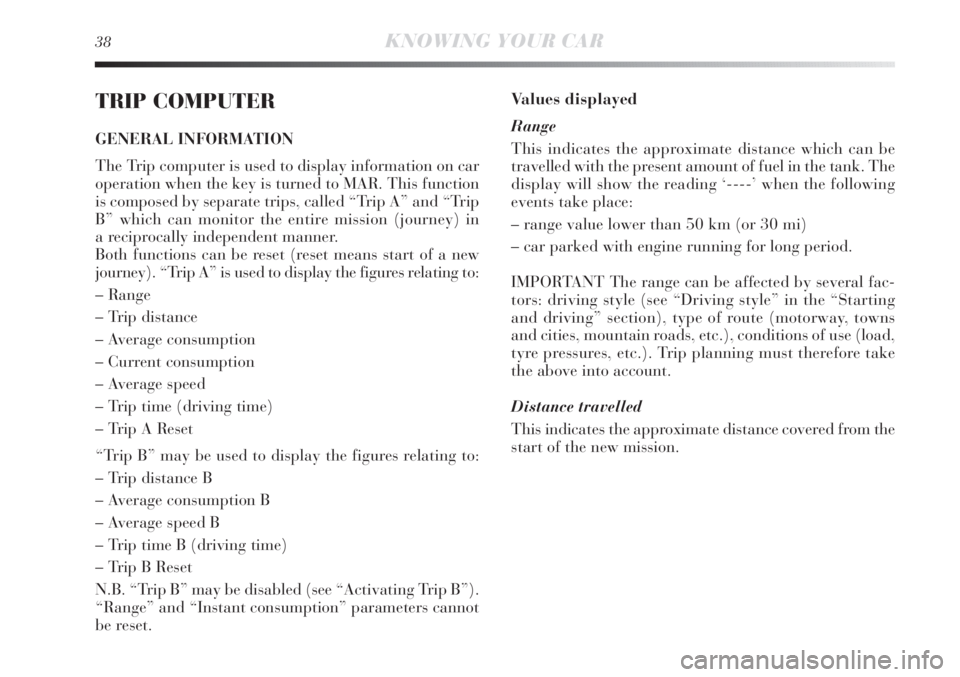
38KNOWING YOUR CAR
TRIP COMPUTER
GENERAL INFORMATION
The Trip computer is used to display information on car
operation when the key is turned to MAR. This function
is composed by separate trips, called “Trip A” and “Trip
B” which can monitor the entire mission (journey) in
a reciprocally independent manner.
Both functions can be reset (reset means start of a new
journey). “Trip A” is used to display the figures relating to:
– Range
– Trip distance
– Average consumption
– Current consumption
– Average speed
– Trip time (driving time)
– Trip A Reset
“Trip B” may be used to display the figures relating to:
– Trip distance B
– Average consumption B
– Average speed B
– Trip time B (driving time)
– Trip B Reset
N.B. “Trip B” may be disabled (see “Activating Trip B”).
“Range” and “Instant consumption” parameters cannot
be reset.Values displayed
Range
This indicates the approximate distance which can be
travelled with the present amount of fuel in the tank. The
display will show the reading ‘----’ when the following
events take place:
– range value lower than 50 km (or 30 mi)
– car parked with engine running for long period.
IMPORTANT The range can be affected by several fac-
tors: driving style (see “Driving style” in the “Starting
and driving” section), type of route (motorway, towns
and cities, mountain roads, etc.), conditions of use (load,
tyre pressures, etc.). Trip planning must therefore take
the above into account.
Distance travelled
This indicates the approximate distance covered from the
start of the new mission.
Page 126 of 295
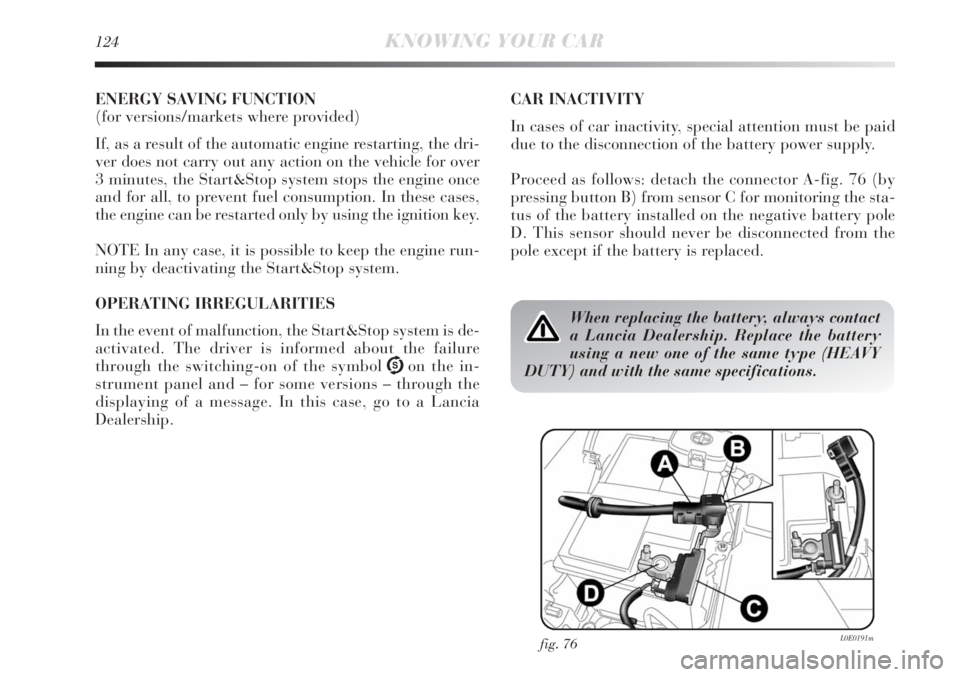
124KNOWING YOUR CAR
ENERGY SAVING FUNCTION
(for versions/markets where provided)
If, as a result of the automatic engine restarting, the dri-
ver does not carry out any action on the vehicle for over
3 minutes, the Start&Stop system stops the engine once
and for all, to prevent fuel consumption. In these cases,
the engine can be restarted only by using the ignition key.
NOTE In any case, it is possible to keep the engine run-
ning by deactivating the Start&Stop system.
OPERATING IRREGULARITIES
In the event of malfunction, the Start&Stop system is de-
activated. The driver is informed about the failure
through the switching-on of the symbol Uon the in-
strument panel and – for some versions – through the
displaying of a message. In this case, go to a Lancia
Dealership.CAR INACTIVITY
In cases of car inactivity, special attention must be paid
due to the disconnection of the battery power supply.
Proceed as follows: detach the connector A-fig. 76 (by
pressing button B) from sensor C for monitoring the sta-
tus of the battery installed on the negative battery pole
D. This sensor should never be disconnected from the
pole except if the battery is replaced.
fig. 76L0E0191m
When replacing the battery, always contact
a Lancia Dealership. Replace the battery
using a new one of the same type (HEAVY
DUTY) and with the same specifications.
Page 154 of 295
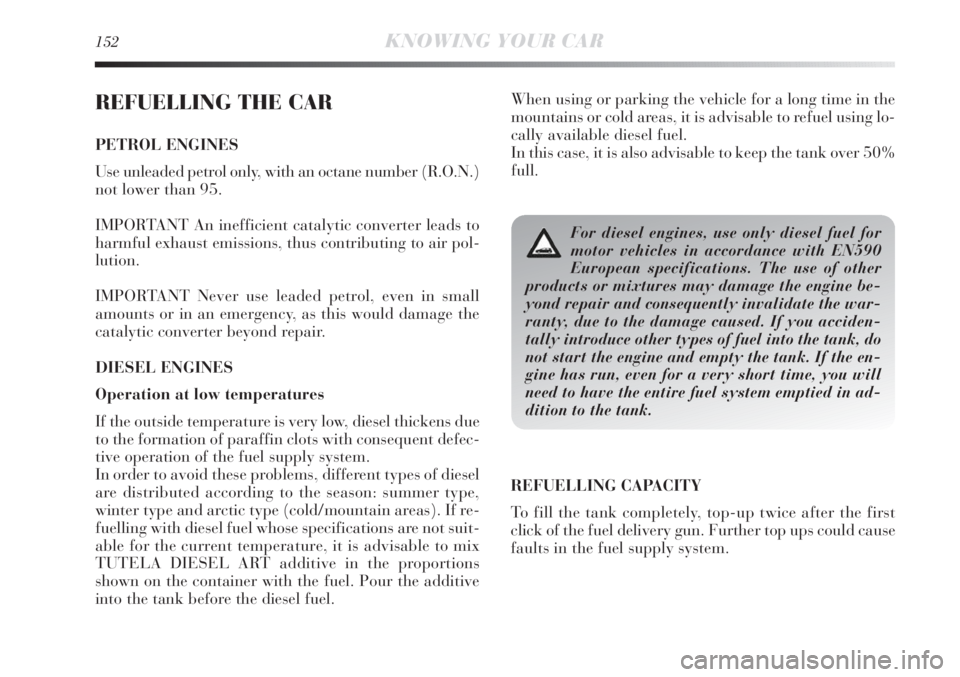
152KNOWING YOUR CAR
REFUELLING THE CAR
PETROL ENGINES
Use unleaded petrol only, with an octane number (R.O.N.)
not lower than 95.
IMPORTANT An inefficient catalytic converter leads to
harmful exhaust emissions, thus contributing to air pol-
lution.
IMPORTANT Never use leaded petrol, even in small
amounts or in an emergency, as this would damage the
catalytic converter beyond repair.
DIESEL ENGINES
Operation at low temperatures
If the outside temperature is very low, diesel thickens due
to the formation of paraffin clots with consequent defec-
tive operation of the fuel supply system.
In order to avoid these problems, different types of diesel
are distributed according to the season: summer type,
winter type and arctic type (cold/mountain areas). If re-
fuelling with diesel fuel whose specifications are not suit-
able for the current temperature, it is advisable to mix
TUTELA DIESEL ART additive in the proportions
shown on the container with the fuel. Pour the additive
into the tank before the diesel fuel.When using or parking the vehicle for a long time in the
mountains or cold areas, it is advisable to refuel using lo-
cally available diesel fuel.
In this case, it is also advisable to keep the tank over 50%
full.
For diesel engines, use only diesel fuel for
motor vehicles in accordance with EN590
European specifications. The use of other
products or mixtures may damage the engine be-
yond repair and consequently invalidate the war-
ranty, due to the damage caused. If you acciden-
tally introduce other types of fuel into the tank, do
not start the engine and empty the tank. If the en-
gine has run, even for a very short time, you will
need to have the entire fuel system emptied in ad-
dition to the tank.
REFUELLING CAPACITY
To fill the tank completely, top-up twice after the first
click of the fuel delivery gun. Further top ups could cause
faults in the fuel supply system.
Page 156 of 295
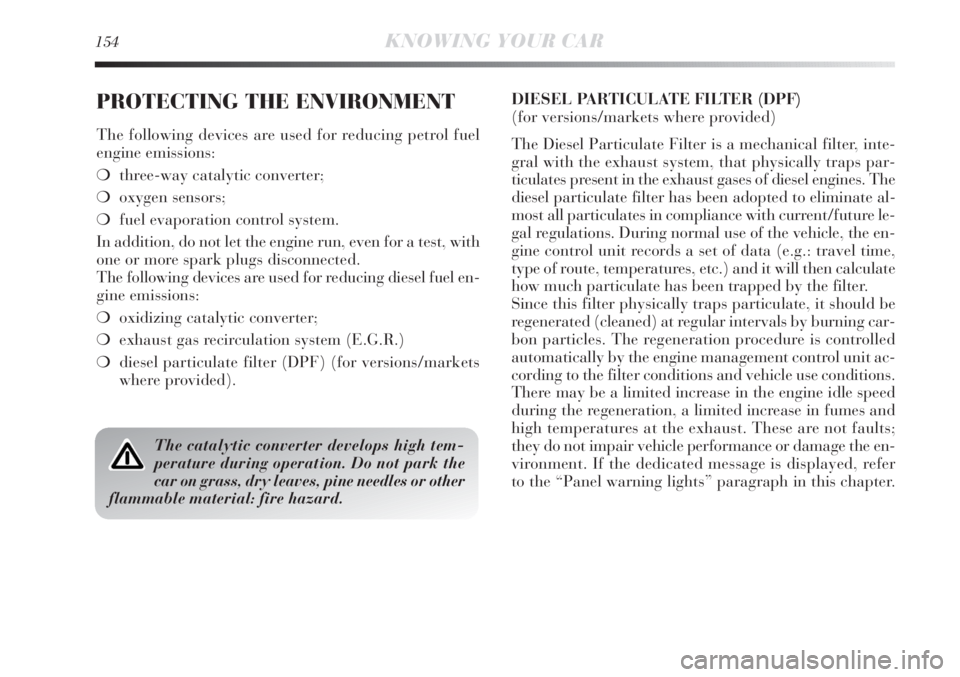
154KNOWING YOUR CAR
PROTECTING THE ENVIRONMENT
The following devices are used for reducing petrol fuel
engine emissions:
❍three-way catalytic converter;
❍oxygen sensors;
❍fuel evaporation control system.
In addition, do not let the engine run, even for a test, with
one or more spark plugs disconnected.
The following devices are used for reducing diesel fuel en-
gine emissions:
❍oxidizing catalytic converter;
❍exhaust gas recirculation system (E.G.R.)
❍diesel particulate filter (DPF) (for versions/markets
where provided).DIESEL PARTICULATE FILTER (DPF)
(for versions/markets where provided)
The Diesel Particulate Filter is a mechanical filter, inte-
gral with the exhaust system, that physically traps par-
ticulates present in the exhaust gases of diesel engines. The
diesel particulate filter has been adopted to eliminate al-
most all particulates in compliance with current/future le-
gal regulations. During normal use of the vehicle, the en-
gine control unit records a set of data (e.g.: travel time,
type of route, temperatures, etc.) and it will then calculate
how much particulate has been trapped by the filter.
Since this filter physically traps particulate, it should be
regenerated (cleaned) at regular intervals by burning car-
bon particles. The regeneration procedure is controlled
automatically by the engine management control unit ac-
cording to the filter conditions and vehicle use conditions.
There may be a limited increase in the engine idle speed
during the regeneration, a limited increase in fumes and
high temperatures at the exhaust. These are not faults;
they do not impair vehicle performance or damage the en-
vironment. If the dedicated message is displayed, refer
to the “Panel warning lights” paragraph in this chapter.
The catalytic converter develops high tem-
perature during operation. Do not park the
car on grass, dry leaves, pine needles or other
flammable material: fire hazard.
Page 263 of 295

198A4000
Otto
4 in line
72 x 84
1368
9.8
± 0.2
88
120
5000
206
21
1750
NGK IKR9F8
Unleaded petrol 95 RON
(EN 228 specification)
198A7000
Otto
4 in line
72 x 84
1368
9.8
103
140
5000
230
23.4
1750
NGK IKR9F8
Unleaded petrol 95 RON
(EN 228 specification)
TECHNICAL SPECIFICATIONS261
6
ENGINE
GENERAL INFORMATION 1.4 Turbo Jet 120 HP 1.4 Turbo Multi Air
Type code
Cycle
Number and arrangement of cylinders
Piston bore and stroke mm
Total displacement cm3
Compression ratio
Max power (EEC) kW
HP
corresponding speed rpm
Max. torque (EEC) Nm
kgm
corresponding speed rpm
Spark plugs
Fuel
Page 281 of 295

TECHNICAL SPECIFICATIONS279
6
FUEL CONSUMPTION
The fuel consumption figures given in the table below are
determined on the basis of the type-approval tests laid
down by specific European Directives.
The procedures below are followed for measuring con-
sumption:
❍urban cycle: cold starting followed by driving that
simulates urban use of the car;
❍extra-urban cycle: frequent accelerations in all gears,
simulating extra-urban use of the vehicle: speed varies
between 0 and 120 km/h;
❍combined consumption: calculated with a weighting
of about 37% of urban cycle consumption and about
63% of extra-urban consumption.IMPORTANT The type of route, traffic situations,
weather conditions, driving style, general conditions of
the car, trim level/equipment/accessories, load, climate
control system, roof rack, other situations that affect air
drag may lead to different fuel consumption levels than
those measured.
FUEL CONSUMPTION ACCORDING TO THE CURRENT EUROPEAN DIRECTIVE (litres/100 km)
1.4 Turbo Jet
120 HP1.4 Turbo
Multi Air1.6 Multijet
105 HP1.6 Multijet
115 HP/120 HP
1.9 Twin Turbo
Multijet2.0 Multijet
Urban8.17.35.87.36.7
Extra-urban5.24.84.04.74.2
6.35.74.75.75.1Combined5.7
3.9
4.6